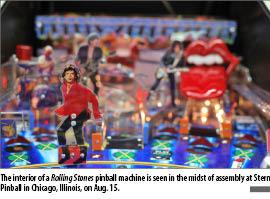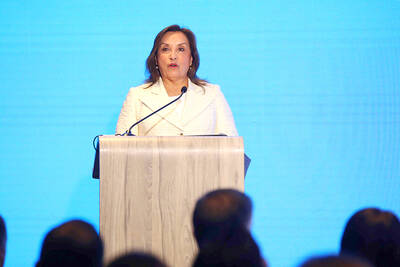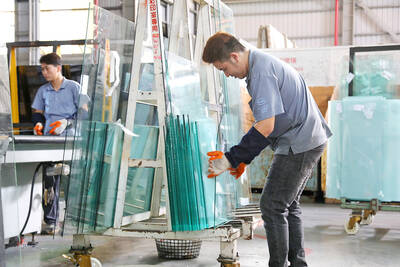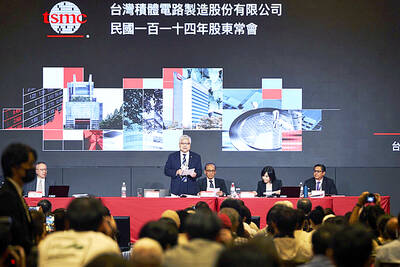Gary Stern has a quick answer for anyone who says he runs the last pinball machine company in the world: It is not the last — it is simply the only pinball company.
Stern, 58, was born into the pinball business and is determined to keep it alive.
His father ran a top pinball manufacturer back in the day when the flipper machines were banned in Chicago, New York and other US cities as gambling devices.

Photo: AFP
Stern saw the machines become cultural icons as generations of kids with a quarter or two burning a hole in their pockets slapped at flippers to keep a shiny silver ball spinning around the tilted play field.
Even when the arcades started to get crowded with video games like Pac-Man, pinball was able to hold its own. However, computer games, home game systems like Nintendo and finally cell phone apps emptied the arcades.
One by one, Stern’s competitors failed or simply walked away from pinball.
Annual sales of new pinball machines have plummeted from a peak of about 100,000 in the 1990s to the 6,000 machines that Stern Pinball sells worldwide.
A core group of enthusiasts has kept the iconic machines from the scrap heap and Stern is confident his US$30 million a year business will remain strong — and profitable — for years to come.
“We make good games. Our games are fun,” Stern said during a tour of his factory in an industrial park near Chicago’s main airport. “The ball is wild. It’s not programmed. You can play pinball on a computer, a simulation of it, but that’s not [real] — it’s all programmed.”
Joshua Henderson, 14, got into pinball the old-fashioned way. He watched his dad play a round on a machine at a bowling alley and started bugging him for quarters.
Henderson’s father signed him up for a tournament near their Plainfield, Illinois, home because it seemed like a good deal: The US$10 registration fee was all it would cost for Joshua to play all day.
That’s where they discovered that Henderson is a pinball wizard.
He placed fifth at the PAPA World Pinball Championships in Pennsylvania last month and has used nearly US$10,000 in winnings to buy a Spiderman-themed pinball machine and build up a college savings fund.
Like most kids his age, Henderson likes video games, but there is something different about pinball, he says, something that keeps him engaged.
“One of the main quirks about it is that you can use your physical strength to control the ball. You’re in control,” he said. “It has a little more strategy than video games and is non-linear too, so every ball is different.”
Henderson is part of a growing number of pinball enthusiasts who see the game as a competitive sport.
“It’s never been bigger than it is now,” said Josh Sharpe, president of the International Flipper Pinball Association.
Sharpe, 31, revived the association in 2006 and has helped it grow to more than 10,000 ranked players in just five years.
Like Stern, he was born into pinball. Three of the 17 machines in Sharpe’s basement were designed by his father when he worked at Williams, the same company Stern’s father used to run. Sharpe, though, is a little embarrassed by the machine that has his mother’s face superimposed on a scantily clad damsel-in-distress and his father’s visage on the knight about to rescue her.
Sharpe ranks sixth in the cumulative world rankings and his brother Zach is ranked seventh.
“Anyone that doesn’t know what they’re doing plays in fear of the ball going down,” Sharpe said.
Competitive players approach the game in a totally different way, Sharpe said. They learn where to shoot for higher points. They develop a strategy that he describes as a combination of chess and golf.
“When I play a game of pinball I’m looking at the playfield for areas where I want to be and where I don’t, whereas a casual player just doesn’t want the ball to go down,” he said.
There are rumors flying around the pinball world that someone is going to try to start up a new pinball company.
Sharpe — who works as an accountant at a gaming company — does not think they will have too much luck. The start-up costs are just too high. The engineering too complex. The market too small and too demanding.
Walking through the Stern factory it is easy to see why Sharpe is skeptical.
Each machine uses over a half a mile of wire it takes more than 30 hours to assemble about 3,500 parts.
Stern spends about US$750,000 designing each game and puts out three or four new ones every year.
They all use licensed themes to draw in the fans — Tron, the Rolling Stones, Iron Man, Avatar and Shrek are the current titles — and the goal is to make each game a different experience from the next.
The Rolling Stones has a Mick Jagger figurine which dances back and forth across the playfield blocking the ball, while the band’s signature red lips and tongue perches on top of one of the ramps.
Tron shares the eerie glow of the movie sequel to light its two ramps and uses a miniature of the Tron arcade game that sucked the hero into a computerized world as a target.
“My father taught me that a pinball machine is like a movie,” Stern said. “It’s got to have a theme, action, a climax, good photography or art work, good sound effects, good promotion, good distribution. Same thing.”

With an approval rating of just two percent, Peruvian President Dina Boluarte might be the world’s most unpopular leader, according to pollsters. Protests greeted her rise to power 29 months ago, and have marked her entire term — joined by assorted scandals, investigations, controversies and a surge in gang violence. The 63-year-old is the target of a dozen probes, including for her alleged failure to declare gifts of luxury jewels and watches, a scandal inevitably dubbed “Rolexgate.” She is also under the microscope for a two-week undeclared absence for nose surgery — which she insists was medical, not cosmetic — and is

CAUTIOUS RECOVERY: While the manufacturing sector returned to growth amid the US-China trade truce, firms remain wary as uncertainty clouds the outlook, the CIER said The local manufacturing sector returned to expansion last month, as the official purchasing managers’ index (PMI) rose 2.1 points to 51.0, driven by a temporary easing in US-China trade tensions, the Chung-Hua Institution for Economic Research (CIER, 中華經濟研究院) said yesterday. The PMI gauges the health of the manufacturing industry, with readings above 50 indicating expansion and those below 50 signaling contraction. “Firms are not as pessimistic as they were in April, but they remain far from optimistic,” CIER president Lien Hsien-ming (連賢明) said at a news conference. The full impact of US tariff decisions is unlikely to become clear until later this month

GROWING CONCERN: Some senior Trump administration officials opposed the UAE expansion over fears that another TSMC project could jeopardize its US investment Taiwan Semiconductor Manufacturing Co (TSMC, 台積電) is evaluating building an advanced production facility in the United Arab Emirates (UAE) and has discussed the possibility with officials in US President Donald Trump’s administration, people familiar with the matter said, in a potentially major bet on the Middle East that would only come to fruition with Washington’s approval. The company has had multiple meetings in the past few months with US Special Envoy to the Middle East Steve Witkoff and officials from MGX, an influential investment vehicle overseen by the UAE president’s brother, the people said. The conversations are a continuation of talks that

CHIP DUTIES: TSMC said it voiced its concerns to Washington about tariffs, telling the US commerce department that it wants ‘fair treatment’ to protect its competitiveness Taiwan Semiconductor Manufacturing Co (TSMC, 台積電) yesterday reiterated robust business prospects for this year as strong artificial intelligence (AI) chip demand from Nvidia Corp and other customers would absorb the impacts of US tariffs. “The impact of tariffs would be indirect, as the custom tax is the importers’ responsibility, not the exporters,” TSMC chairman and chief executive officer C.C. Wei (魏哲家) said at the chipmaker’s annual shareholders’ meeting in Hsinchu City. TSMC’s business could be affected if people become reluctant to buy electronics due to inflated prices, Wei said. In addition, the chipmaker has voiced its concern to the US Department of Commerce